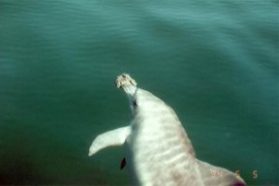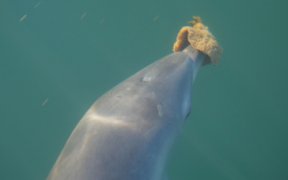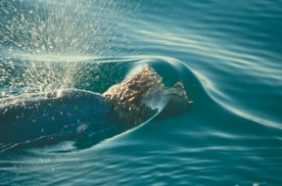Dolphin Sponge Moms
Young dolphins learn tool use from their mothers.
By Emily Sohn
There are dolphins in Australia that carry sea sponges on their beaks. Worn like a sort of glove, a sponge appears to protect a dolphin when it pokes around on the bottom of the bay where it lives and bumps into stinging critters that lurk down there, waiting to attack.
 |
|
Demi, a female dolphin, carries a sponge. In 1985, her mother, Half-Fluke, was the first sponge carrier identified in Shark Bay, Australia. Demi’s daughter, Dodger, also carries sponges. |
| PNAS/Photos by Janet Mann |
Scientists first spotted the sponging dolphins in Shark Bay 20 years ago, but they didn’t know where the behavior came from. Now, a new study suggests that the dolphins don’t figure out the trick on their own, nor do they inherit the ability. Instead, they learn it from their mothers.
It’s an exciting, new example of how animals learn to use tools, then teach others how to use them. Chimpanzees, crows, and other animals do similar things.
 |
|
Dodger, a 2-year-old female dolphin, carries a sponge. |
| PNAS/Photos by Janet Mann |
To investigate the origins of sponging, Michael Krützen of the University of Zurich in Switzerland and his coworkers studied 185 bottlenose dolphins in Shark Bay. Thirteen of the animals used sponges. The rest did not.
All but one of the spongers had identical stretches of the genetic material known as DNA, the researchers found. This finding suggested that the sponging dolphins were related to one another and that the sponging trait might be something they were born with.
Further investigation, however, showed that genes could not explain the behavior. Most sponging dolphins are female, and spongers live alongside non-spongers. Mother-daughter sponge school is the only explanation that made sense.
 |
|
Spongemom, an adult female dolphin, has shown sponge-carrying behavior for at least 20 years. |
| PNAS/Photos by Janet Mann |
The study provides a good example of something that these animals have in common with people. Where would you be, after all, without all the things you’ve learned from adults?—E. Sohn
Going Deeper:
Milius, Susan. 2005. Sponge moms: Dolphins learn tool use from their mothers. Science News 167(June 11):371-372. Available at http://www.sciencenews.org/articles/20050611/fob2.asp .
You can learn more about bottlenose dolphins at www.acsonline.org/factpack/btlnose.htm (American Cetacean Society).
Sohn, Emily. 2005. Tool use comes naturally to crows. Science News for Kids (Jan. 19). Available at http://www.sciencenewsforkids.org/articles/20050119/Note3.asp .
______. 2004. An inspiring home for apes. Science News for Kids (July 14). Available at http://www.sciencenewsforkids.org/articles/20040714/Feature1.asp .
______. 2003. Better tools for techno crows. Science News for Kids (March 26). Available at http://www.sciencenewsforkids.org/articles/20030326/Note3.asp .







